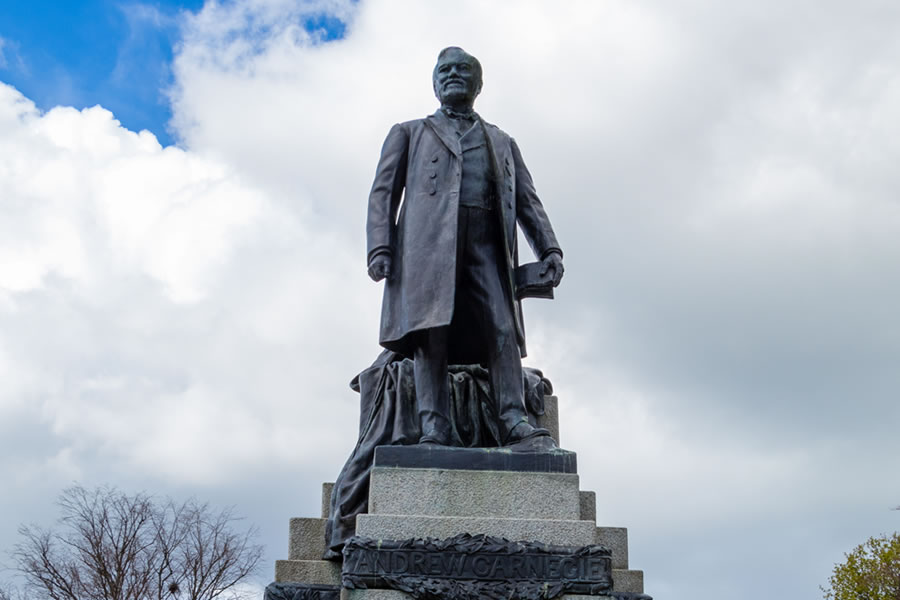Carnegie
Dunfermline’s most famous son
The linen industry developed in West Fife in the 18th century, and Dunfermline in particular soon became internationally renowned as a textile town. Its factories were particularly famed for their high-quality damask linen and silk. It was in a weaver’s cottage that Dunfermline’s most famous son, the millionaire philanthropist Andrew Carnegie, was born in 1835. In 1848 changes in the linen trade prompted the family to emigrate to Pittsburgh in the United States of America.

The origins of Carnegie
Working as a teenager in a cotton factory, and later for a telegraph company, Carnegie invested small sums in railroads and a number of other businesses, before focusing on the iron and steel in the 1870s. Carnegie’s success in these industries has been credited to his ruthless business tactics, including union breaking, innovative management structures, and embracing of modern technological innovations. Following the consolidation of his interests into the vast United States Steel Corporation, Carnegie retired in 1900/1901, one of the richest men in the world.
Retirement allowed Carnegie to devote more time to his passion for philanthropy. In the remaining years of his life, he gave away somewhere in the region of 90% of his wealth. Several bequests were made to his hometown, beginning in 1873 when he gave $25,000 to funding a public swimming bath in Dunfermline.
Carnegie’s Legacy
In 1881 he paid for a free library in the town, the first of 2,811 Carnegie libraries which he founded across the world. It is now the Dunfermline Carnegie Library & Galleries which reopened following a major refurbishment in 2017. Carnegie also made a significant contribution to a library and museum in Kinross, opened in 1905. In 1902 he purchased Pittencrieff Park, or ‘The Glen’ as it is more often known by local people, a 76-acre park to the west of the centre of Dunfermline. Well known for its resident peacocks, it was presented by Carnegie to the people of the city in 1903, with its maintenance paid for by the Carnegie Dunfermline Trust, a fund set up to in Carnegie’s words to provide ‘Sweetness and Light’ for the townspeople, which has funded arts and music events, and supported local clubs and organisations ever since.
Further reading
• Joseph Frazier Wall, Andrew Carnegie (Oxford,1970)
• David Nasaw, Andrew Carnegie (New York, London 2007)
5 ways to improve your wellbeing through heritage

Keep Learning at Andrew Carnegie Birthplace Museum
The museum incorporates the traditional weaver’s cottage where Carnegie was born together with a working loom. In addition to his extraordinary life story the museum illustrates his worldwide legacy of philanthropy. The extensive collections include unique historic photographs, presentation caskets, dinosaur fossils, personal possessions, documents, works of art, and scientific equipment. They have regular events taking place throughout the year. More information on visiting.
Be Active at Carnegie Leisure Centre
Opened in 1905, the building originally housed a swimming bath, Turkish baths, and aero tone baths. Following modernisation in the 1970’s, 1980’s and 1990’s the building now houses a 25-metre swimming pool, a 25-metre training pool, a toddler’s swimming pool, a sauna and steam room, a gym, fitness studios, sport halls, squash courts, climbing wall, soft play, and a café. More information on visiting.
Connect with others at Dunfermline Carnegie Library & Galleries
The world’s first Carnegie library has a volunteer archive group that meet weekly in the local history reading room. Call the local studies team for more information: 01383 602365
Take Notice in Pittencrieff Park
Despite the popularity of Pittencrieff Park, there are many quiet places for reflection and connection in the park. In early May, you can enjoy the stunning display of blossom and in the summer the bees are buzzing in the Laird’s Garden with it’s wide herbacious border. If you like the sound of running water, a walk through the glen with the company of the Tower burn is very relaxing.
Give your time at Andrew Carnegie Birthplace Museum
The museum encourages volunteers, especially those involved in Duke of Edinburgh and school, college or university credit schemes. To find out more, contact the musuem.
